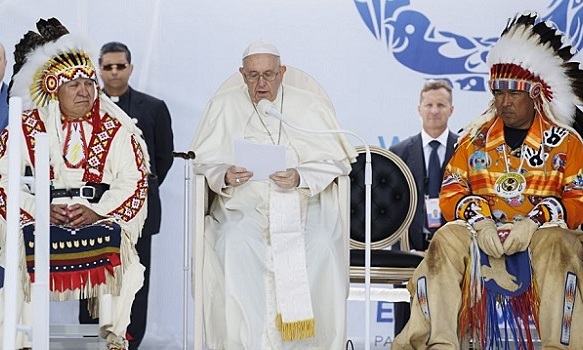In a historic visit, Pope Francis, leader of the world’s 1.3 billion Catholics, sets off on what he calls his “penitential pilgrimage” to apologise for the “evil” inflicted on the Indigenous peoples of Canada in the residential schools run by Roman Catholic religious orders of priests and nuns. This was the first apology by a Pope on Canadian soil, delivered to First Nations, Metis and Inuit people.
The scandals of the Catholic Church came to the fore last year when the remains of 215 children at a former residential school in British Columbia in unmarked graves. Since then 1300 more such unmarked graves were found all over the country at the sites of the former schools.
These graves signified years of sufferings, in the form of sexual abuse, rape, starvation, physical and mental torture, cultural destruction and death of about 150,000 indigenous children who were separated from their families and brought to Catholic, residential schools as part of a policy of forced assimilation between the years 1881 and 1996.
Recognising these horrors Pope Francis spoke in his first address to the indigenous leaders along with Canadian Prime Minister Justin Trudeau and Mary Simon, the country’s first Indigenous governor general and said “I am sorry”.
“Sorry for the ways in which, regrettably, many Christians supported the colonizing mentality of the powers that oppressed the indigenous peoples. I am sorry,” he said. “In the face of this deplorable evil, the Church kneels before God and implores his forgiveness for the sins of her children.”
His half hour speech contained words of “deep sense of pain and remorse” and a formal acknowledgment of the involvement of “many members of the Church” and their participation and cooperation in an abusive system.
“I humbly beg forgiveness for the evil committed by so many Christians against the Indigenous peoples,” pleaded the pope, citing “cultural destruction” and the “physical, verbal, psychological and spiritual abuse” of children over the course of a century.
The atmosphere in the Ermineskin residential school was an emotional one. The large crowd dressed in traditional indigenous clothes wiped their tears and were seen hugging one another. It is unclear whether the reconciliation attempt by the Pope healed the wounds of the past. Behind the pomp and festive celebrations of the event, there were some mixed reactions of hope and wariness.
“For survivors from coast to coast, this is an opportunity — the first and maybe the last — to perhaps find some closure for themselves and their families,” said Chief Randy Ermineskin of the Ermineskin Cree Nation.
“This will be a difficult process but a necessary one,” he told the news agency AP.
For some others this visit, these words were a typical case of too little too late.
“For me it’s kind of too late, because a lot of the people suffered, and the priests and the nuns have now passed on.” Saint Paul told the AFP news agency.
For many survivors and indigenous leaders, words of acknowledgment aren’t enough. They want action in the form of financial compensation, the return of artifacts sent to the Vatican by missionaries, the release of abuse records from the Vatican archives, and most importantly – punishment for the alleged abusers who’re still alive.




















Comments